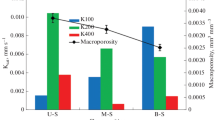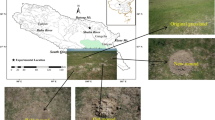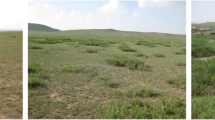Abstract
Purpose
Preferential flow via soil macropores can have a large effect on water quality. Hence, it is important to quantify soil macropore characteristics to better understand preferential flow behavior in soils. Currently, little information exists on the changes in soil macroporosity in response to topographical position within a field and how macropore characteristics change temporally. The objective of this study was to use X-ray computed tomography (CT) and image analysis to quantify temporal and spatial variability in 3D soil macropore structure in a 0.40 ha pasture field.
Methods
A total of 36 undisturbed soil columns, 150 mm in diameter and 500 mm in length, were collected during May and September of 2019 from a pasture field located in Alabama, USA. The image analysis was performed to quantify spatial and temporal variability in soil macropore characteristics.
Results and discussion
The macropore characteristics varied significantly between different topographical positions and sampling seasons, especially at the surface layer (0–100 mm) depth. The soil macropores at the downslope position were sparsely distributed in the surface soil layer. This was attributed to a relatively higher degree of grazing-induced compaction due to higher soil moisture as compared to the upslope and midslope locations. In contrast, dense macropore networks were observed at the downslope positions for depths greater than 250 mm.
Conclusions
The results of this study show that macropore characteristics varied as a function of topography and time. Except macropore diameter, all other macropore characteristics showed an increasing trend from season 1 (spring) to season 2 (fall). The regeneration of macropores was mainly attributed to the wetting and drying cycles that promoted formation of smaller macropores (0.70–1 mm) at the surface soil, thereby reducing the average macropore diameter. Significant differences in the macropore characteristics were observed mostly in the surface layer (0–100 mm).





Similar content being viewed by others
References
Balkcom KS, Reeves DW, Kemble JM (2010) Tillage requirements of sweet corn, field pea, and watermelon following stocker cattle grazing. J Sustain Agric 34:169–182. https://doi.org/10.1080/10440040903482571
Bodner G, Scholl P, Loiskandl W, Kaul HP (2013) Environmental and management influences on temporal variability of near saturated soil hydraulic properties. Geoderma 204–205:120–129. https://doi.org/10.1016/j.geoderma.2013.04.015
Bottinelli N, Hallaire V, Goutal N (2014) Impact of heavy traffic on soil macroporosity of two silty forest soils: Initial effect and short-term recovery. Geoderma 217–218:10–17. https://doi.org/10.1016/j.geoderma.2013.10.025
Bouyoucos GJ (1962) Hydrometer method improved for making particle size analyses of soils. Agron J 54:464–465. https://doi.org/10.2134/agronj1962.00021962005400050028x
Cameira MR, Fernando RM, Pereira LS (2003) Soil macropore dynamics affected by tillage and irrigation for a silty loam alluvial soil in southern Portugal. Soil Tillage Res 70:131–140. https://doi.org/10.1016/S0167-1987(02)00154-X
Cattle SR, Southorn NJ (2010) Macroporosity of pasture topsoils after three years of set-stocked and rotational grazing by sheep. Aust J Soil Res 48:43–57. https://doi.org/10.1071/SR09004
Cougnon M, De Swaef T, Lootens P (2017) In situ quantification of forage grass root biomass, distribution and diameter classes under two N fertilisation rates. Plant Soil 411:409–422. https://doi.org/10.1007/s11104-016-3034-7
Domúnguez-Niño JM, Arbat G, Raij-Hoffman I (2020) Parameterization of soil hydraulic parameters for HYDRUS-3D simulation of soil water dynamics in a drip-irrigated orchard. Water (Switzerland) 12. https://doi.org/10.3390/W12071858
Dörner J, Dec D, Peng X, Horn R (2010) Effect of land use change on the dynamic behaviour of structural properties of an Andisol in southern Chile under saturated and unsaturated hydraulic conditions. Geoderma 159:189–197. https://doi.org/10.1016/j.geoderma.2010.07.011
Doube M, Klosowski MM, Arganda-Carreras I (2010) BoneJ: Free and extensible bone image analysis in ImageJ. Bone 47:1076–1079. https://doi.org/10.1016/j.bone.2010.08.023
Dougherty R, Kunzelmann K-H (2007) Computing local thickness of 3D structures with ImageJ. Microsc Microanal 13:1678–1679. https://doi.org/10.1017/s1431927607074430
Głąb T (2007) Effect of soil compaction on root system morphology and yields of tall fescue. Int Agrophysics 21:233–239
Greenwood KL, McKenzie BM (2001) Grazing effects on soil physical properties and the consequences for pastures: a review. Aust J Exp Agric 41:1231–1250. https://doi.org/10.1071/EA00102
Grosbellet C, Vidal-Beaudet L, Caubel V, Charpentier S (2011) Improvement of soil structure formation by degradation of coarse organic matter. Geoderma 162:27–38. https://doi.org/10.1016/j.geoderma.2011.01.003
Holden J (2009) Topographic controls upon soil macropore flow. Earth Surf Process Landforms 34:613–628. https://doi.org/10.1002/esp
Huisman NLH, Karthikeyan KG, Lamba J, Thompson AM, Peaslee G (2013) Quantification of seasonal sediment and phosphorus transport dynamics in an agricultural watershed using radiometric fingerprinting techniques. J Soils Sediments 13:1724–1734. https://doi.org/10.1007/s11368-013-0769-0
Jarvis NJ (2007) A review of non-equilibrium water flow and solute transport in soil macropores: Principles, controlling factors and consequences for water quality. Eur J Soil Sci 58:523–546. https://doi.org/10.1111/j.1365-2389.2007.00915.x
Jefferies DA, Heck RJ, Thevathasan NV, Gordon AM (2014) Characterizing soil surface structure in a temperate tree-based intercropping system using X-ray computed tomography. Agrofor Syst 88:645–656. https://doi.org/10.1007/s10457-014-9699-0
Katuwal S, Norgaard T, Moldrup P (2015) Linking air and water transport in intact soils to macropore characteristics inferred from X-ray computed tomography. Geoderma 237–238:9–20. https://doi.org/10.1016/j.geoderma.2014.08.006
Koestel J, Jorda H (2014) What determines the strength of preferential transport in undisturbed soil under steady-state flow? Geoderma 217–218:144–160. https://doi.org/10.1016/j.geoderma.2013.11.009
Lamba J, Way TR, Srivastava P (2012) Surface transport of nutrients from surface-broadcast and subsurface-banded broiler litter. Trans ASABE 55:979–985
Li XW, McCarty G (2019) Application of topographic analyses for mapping spatial patterns of soil properties. Earth Obs Geospatial Anal [Working Title]. https://doi.org/10.5772/intechopen.86109
Luo L, Lin H, Li S (2010a) Quantification of 3-D soil macropore networks in different soil types and land uses using computed tomography. J Hydrol 393:53–64. https://doi.org/10.1016/j.jhydrol.2010.03.031
Luo L, Lin H, Schmidt J (2010b) Quantitative relationships between soil macropore characteristics and preferential flow and transport. Soil Sci Soc Am J 74:1929–1937. https://doi.org/10.2136/sssaj2010.0062
Müller K, Katuwal S, Young I (2018) Characterising and linking X-ray CT derived macroporosity parameters to infiltration in soils with contrasting structures. Geoderma 313:82–91. https://doi.org/10.1016/j.geoderma.2017.10.020
Munkholm LJ, Heck RJ, Deen B (2012) Soil pore characteristics assessed from X-ray micro-CT derived images and correlations to soil friability. Geoderma 181–182:22–29. https://doi.org/10.1016/j.geoderma.2012.02.024
Oztas T, Koc A, Comakli B (2003) Changes in vegetation and soil properties along a slope on overgrazed and eroded rangelands. J Arid Environ 55:93–100. https://doi.org/10.1016/S0140-1963(02)00267-7
Pagenkemper SK, Puschmann DU, Peth S, Horn R (2014) Investigation of time dependent development of soil structure and formation of macropore networks as affected by various precrop species. Int Soil Water Conserv Res 2:51–66. https://doi.org/10.1016/S2095-6339(15)30006-X
Perret J, Prasher SO, Kanlzas A, Langford C (1998) Characterization of macropore morphology in a sandy loam soil using x-ray computer assisted tomography and geostatistical analysis. Can Water Resour J 23:143–165. https://doi.org/10.4296/cwrj2302143
Phansalkar N, More S, Sabale A, Joshi M (2011) Adaptive local thresholding for detection of. Int Conf Commun Signal Process 218–220
Pires LF, Auler AC, Roque WL, Mooney SJ (2020) X-ray microtomography analysis of soil pore structure dynamics under wetting and drying cycles. Geoderma 362:114103. https://doi.org/10.1016/j.geoderma.2019.114103
Pires LF, Roque WL, Rosa JA, Mooney SJ (2019) 3D analysis of the soil porous architecture under long term contrasting management systems by X-ray computed tomography. Soil Tillage Res 191:197–206. https://doi.org/10.1016/j.still.2019.02.018
Prior SA, Runion GB, Torbert HA, Erbach DC (2004) A hydraulic coring system for soil–root studies. Agron J 96:1202–1205. https://doi.org/10.2134/agronj2004.1202
PRISM Climate Group Oregon State University. Available online at the following link: https://prism.oregonstate.edu/. Accessed 29 Dec 2021.
Pulido-Moncada M, Katuwal S, Ren L (2020) Impact of potential bio-subsoilers on pore network of a severely compacted subsoil. Geoderma 363:114154. https://doi.org/10.1016/j.geoderma.2019.114154
Rab MA, Haling RE, Aarons SR (2014) Evaluation of X-ray computed tomography for quantifying macroporosity of loamy pasture soils. Geoderma 213:460–470. https://doi.org/10.1016/j.geoderma.2013.08.037
Rezaei SA, Gilkes RJ (2005) The effects of landscape attributes and plant community on soil physical properties in rangelands. Geoderma 125:145–154. https://doi.org/10.1016/j.geoderma.2004.07.011
Rueden CT, Schindelin J, Hiner MC (2017) Image J2: ImageJ for the next generation of scientific image data. BMC Bioinformatics 18:1–26. https://doi.org/10.1186/s12859-017-1934-z
Schaap MG, Leij FJ, Th van Genuchten M (2001) Rosetta: a computer program for estimating soil hydraulic parameters with hierarchical pedotransfer functions 251, 163–176.
Sen S, Srivastava P, Yoo KH, Dane J, Shaw JN, Kang MS (2008) Runoff generation mechanisms in pastures of the Sand Mountain region of Alabama-a field investigation. Hydrol Process 14:369–385. https://doi.org/10.1002/hyp.7025
Šimůnek J, van Genuchten Th, M, Šejna M (2016) Recent developments and applications of the HYDRUS computer software packages. Vadose Zo J 15:1–25. https://doi.org/10.2136/vzj2016.04.0033
Singh N, Kumar S, Udawatta RP (2021) X-ray micro-computed tomography characterized soil pore network as influenced by long-term application of manure and fertilizer. Geoderma 385:114872. https://doi.org/10.1016/j.geoderma.2020.114872
Singh P, Kanwar RS, Thompson ML (1991) Macropore characterization for two tillage systems using resin-impregnation technique. Soil Sci Soc Am J 55:1674–1679. https://doi.org/10.2136/sssaj1991.03615995005500060029x
Singleton PL, Boyes M, Addison B (2000) Effect of treading by dairy cattle on topsoil physical conditions for six contrasting soil types in Waikato and Northland, New Zealand, with implications for monitoring. New Zeal J Agric Res 43:559–567. https://doi.org/10.1080/00288233.2000.9513453
Smet S, Beckers E, Plougonven E (2018) Can the pore scale geometry explain soil sample scale hydrodynamic properties? Front Environ Sci 6. https://doi.org/10.3389/fenvs.2018.00020
Soil Survey Staff, Natural Resources Conservation Service, United States Department of Agriculture. Web Soil Survey. Available online at the following link: http://websoilsurvey.sc.egov.usda.gov/. Accessed 20 November 2020.
Udawatta RP, Anderson SH, Gantzer CJ, Garrett HE (2008) Influence of prairie restoration on CT-measured soil pore characteristics. J Environ Qual 37:219–228. https://doi.org/10.2134/jeq2007.0227
Vogel HJ, Weller U, Schlüter S (2010) Quantification of soil structure based on Minkowski functions. Comput Geosci 36:1236–1245. https://doi.org/10.1016/j.cageo.2010.03.007
Vuaille J, Daraghmeh O, Abrahamsen P (2020) Wheel track loosening can reduce the risk of pesticide leaching to surface waters. Soil Use Manag 1–15. https://doi.org/10.1111/sum.12641
Wahl NA, Bens O, Buczko U (2004) Effects of conventional and conservation tillage on soil hydraulic properties of a silty-loamy soil. Phys Chem Earth 29:821–829. https://doi.org/10.1016/j.pce.2004.05.009
Warren SD, Nevill MB, Blackburn WH, Garza NE (1986) Soil response to trampling under intensive rotation grazing. Soil Sci Soc Am J 50:1336–1341. https://doi.org/10.2136/sssaj1986.03615995005000050050x
Watson KW, Luxmoore RJ (1986) Estimating macroporosity in a forest watershed by use of a tension infiltrometer. Soil Sci Soc Am J 50:578–582. https://doi.org/10.2136/sssaj1986.03615995005000030007x
Zhang Z, Lin L, Wang Y, Peng X (2016) Temporal change in soil macropores measured using tension infiltrometer under different land uses and slope positions in subtropical China. J Soils Sediments 16:854–863. https://doi.org/10.1007/s11368-015-1295-z
Zhang Z, Liu K, Zhou H (2019a) Linking saturated hydraulic conductivity and air permeability to the characteristics of biopores derived from X-ray computed tomography. J Hydrol 571:1–10. https://doi.org/10.1016/j.jhydrol.2019.01.041
Zhang Z, Liu K, Zhou H, Lin H, Li D, Peng X (2019b) Linking saturated hydraulic conductivity and air permeability to the characteristics of biopores derived from X-ray computed tomography. J Hydrol 571:1–10. https://doi.org/10.1016/j.jhydrol.2019.01.041
Zong-Chao Li, Hu X, Li XY (2019) Quantification of soil macropores at different slope positions under alpine meadow using computed tomography in the Qinghai Lake watershed, NE Qinghai-Tibet. Eurasian Soil Sci 52:1391–1401. https://doi.org/10.1134/S1064229319110152
Acknowledgements
We thank Marlin R. Siegford, Peyton Heath, Thomas Counts, and staff at the Sand Mountain Research and Extension Center for assistance with this research. The authors would also like to thank Kimberly Bryan and Dr. John Hathcock at Auburn University, College of Veterinary Medicine for assistance with scanning of soil cores.
Funding
This work was supported by a USDA-NIFA AFRI grant (award # 2018–67019-27806), USDA-NIFA Hatch Project (ALA014-1–19052), and the Alabama Agricultural Experiment Station.
Author information
Authors and Affiliations
Corresponding author
Ethics declarations
Conflict of interest
The authors declare no competing interests.
Additional information
Responsible editor: Pariente Sarah
Publisher's Note
Springer Nature remains neutral with regard to jurisdictional claims in published maps and institutional affiliations.
Rights and permissions
About this article
Cite this article
Budhathoki, S., Lamba, J., Srivastava, P. et al. Temporal and spatial variability in 3D soil macropore characteristics determined using X-ray computed tomography. J Soils Sediments 22, 1263–1277 (2022). https://doi.org/10.1007/s11368-022-03150-x
Received:
Accepted:
Published:
Issue Date:
DOI: https://doi.org/10.1007/s11368-022-03150-x




